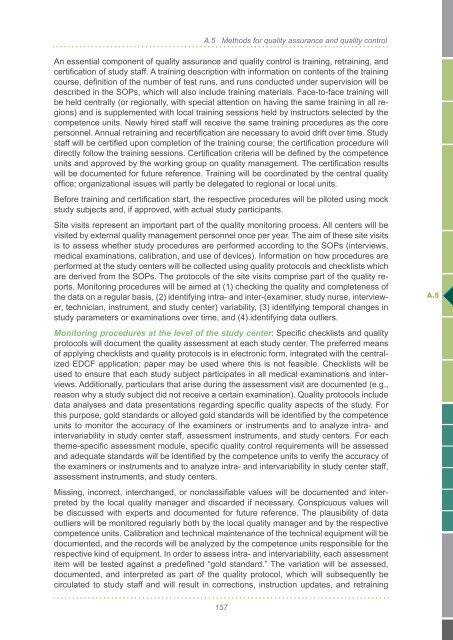Scientific Concept of the National Cohort (status ... - Nationale Kohorte
Scientific Concept of the National Cohort (status ... - Nationale Kohorte
Scientific Concept of the National Cohort (status ... - Nationale Kohorte
Create successful ePaper yourself
Turn your PDF publications into a flip-book with our unique Google optimized e-Paper software.
A.5 Methods for quality assurance and quality control<br />
An essential component <strong>of</strong> quality assurance and quality control is training, retraining, and<br />
certification <strong>of</strong> study staff. A training description with information on contents <strong>of</strong> <strong>the</strong> training<br />
course, definition <strong>of</strong> <strong>the</strong> number <strong>of</strong> test runs, and runs conducted under supervision will be<br />
described in <strong>the</strong> SOPs, which will also include training materials. Face-to-face training will<br />
be held centrally (or regionally, with special attention on having <strong>the</strong> same training in all regions)<br />
and is supplemented with local training sessions held by instructors selected by <strong>the</strong><br />
competence units. Newly hired staff will receive <strong>the</strong> same training procedures as <strong>the</strong> core<br />
personnel. Annual retraining and recertification are necessary to avoid drift over time. Study<br />
staff will be certified upon completion <strong>of</strong> <strong>the</strong> training course; <strong>the</strong> certification procedure will<br />
directly follow <strong>the</strong> training sessions. Certification criteria will be defined by <strong>the</strong> competence<br />
units and approved by <strong>the</strong> working group on quality management. The certification results<br />
will be documented for future reference. Training will be coordinated by <strong>the</strong> central quality<br />
<strong>of</strong>fice; organizational issues will partly be delegated to regional or local units.<br />
Before training and certification start, <strong>the</strong> respective procedures will be piloted using mock<br />
study subjects and, if approved, with actual study participants.<br />
Site visits represent an important part <strong>of</strong> <strong>the</strong> quality monitoring process. All centers will be<br />
visited by external quality management personnel once per year. The aim <strong>of</strong> <strong>the</strong>se site visits<br />
is to assess whe<strong>the</strong>r study procedures are performed according to <strong>the</strong> SOPs (interviews,<br />
medical examinations, calibration, and use <strong>of</strong> devices). Information on how procedures are<br />
performed at <strong>the</strong> study centers will be collected using quality protocols and checklists which<br />
are derived from <strong>the</strong> SOPs. The protocols <strong>of</strong> <strong>the</strong> site visits comprise part <strong>of</strong> <strong>the</strong> quality reports.<br />
Monitoring procedures will be aimed at (1) checking <strong>the</strong> quality and completeness <strong>of</strong><br />
<strong>the</strong> data on a regular basis, (2) identifying intra- and inter-(examiner, study nurse, interviewer,<br />
technician, instrument, and study center) variability, (3) identifying temporal changes in<br />
study parameters or examinations over time, and (4) identifying data outliers.<br />
Monitoring procedures at <strong>the</strong> level <strong>of</strong> <strong>the</strong> study center: Specific checklists and quality<br />
protocols will document <strong>the</strong> quality assessment at each study center. The preferred means<br />
<strong>of</strong> applying checklists and quality protocols is in electronic form, integrated with <strong>the</strong> centralized<br />
EDCF application; paper may be used where this is not feasible. Checklists will be<br />
used to ensure that each study subject participates in all medical examinations and interviews.<br />
Additionally, particulars that arise during <strong>the</strong> assessment visit are documented (e.g.,<br />
reason why a study subject did not receive a certain examination). Quality protocols include<br />
data analyses and data presentations regarding specific quality aspects <strong>of</strong> <strong>the</strong> study. For<br />
this purpose, gold standards or alloyed gold standards will be identified by <strong>the</strong> competence<br />
units to monitor <strong>the</strong> accuracy <strong>of</strong> <strong>the</strong> examiners or instruments and to analyze intra- and<br />
intervariability in study center staff, assessment instruments, and study centers. For each<br />
<strong>the</strong>me-specific assessment module, specific quality control requirements will be assessed<br />
and adequate standards will be identified by <strong>the</strong> competence units to verify <strong>the</strong> accuracy <strong>of</strong><br />
<strong>the</strong> examiners or instruments and to analyze intra- and intervariability in study center staff,<br />
assessment instruments, and study centers.<br />
Missing, incorrect, interchanged, or nonclassifiable values will be documented and interpreted<br />
by <strong>the</strong> local quality manager and discarded if necessary. Conspicuous values will<br />
be discussed with experts and documented for future reference. The plausibility <strong>of</strong> data<br />
outliers will be monitored regularly both by <strong>the</strong> local quality manager and by <strong>the</strong> respective<br />
competence units. Calibration and technical maintenance <strong>of</strong> <strong>the</strong> technical equipment will be<br />
documented, and <strong>the</strong> records will be analyzed by <strong>the</strong> competence units responsible for <strong>the</strong><br />
respective kind <strong>of</strong> equipment. In order to assess intra- and intervariability, each assessment<br />
item will be tested against a predefined “gold standard.” The variation will be assessed,<br />
documented, and interpreted as part <strong>of</strong> <strong>the</strong> quality protocol, which will subsequently be<br />
circulated to study staff and will result in corrections, instruction updates, and retraining<br />
157<br />
A.5



